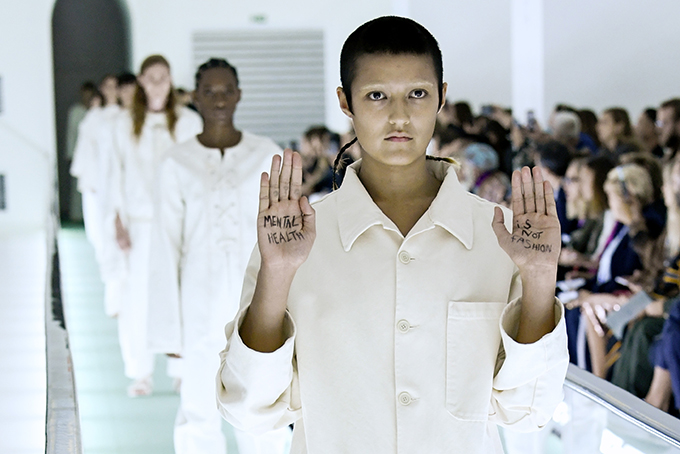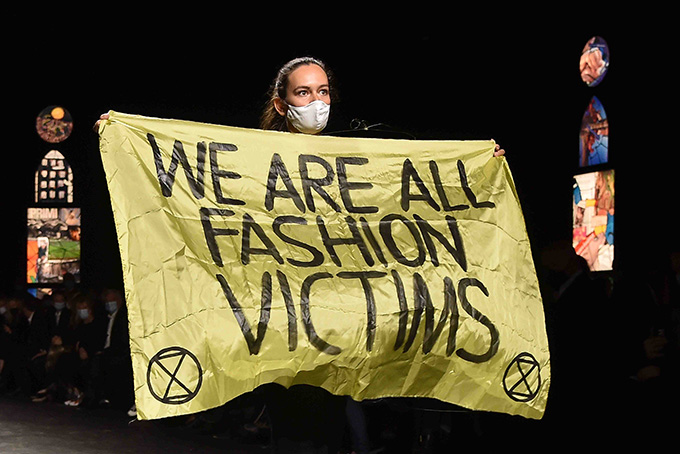Fashion month is no stranger to disruption and drama. Some would even say the industry thrives on chaos and out-of-pocket expressions to keep the momentum going. This past fashion month–spanning New York, London, Paris, and Milan–spectacles of all degrees were embraced both on and off the runway. Jun Takahashi of Undercover revealed a 3D collection with live butterflies illuminated within the seams of dresses, Angela Bassett walked Mugler and Naomi Campbell closed Sarah Burton’s last show for Alexander McQueen after 13 years of occupancy.
Through it all, there’s an underlying craving for performance and a heightened appetite for challenging archaic fashion structures. A figure that calculatedly plays with this desire is the runway crasher. They seem to not only steal the show and captivate the social world but also disturb the very platform that sets the standard for fashion’s future–the runway.

Runway crashers aim to convey gaps in the fashion industry (and beyond). Their work is mainly targeted at discouraging the use of animal products like leather and fur or bringing awareness to the environmental, labour and climate crisis impeded by the industry. Although PETA protesters often cloud the mix, their attempts are not limited to external organisations, with some acts coming from the models themselves.
“With all eyes on fashion week, the medium of the runway has proven to be the go-to spot to reach a target audience.”
At Gucci’s spring/summer 2020 show, model Ayesha Tan-Jones shed light on mental health activism by holding up her hands to reveal “mental health is not fashion” written on their palms, as the collection used straightjackets and outfits mimicking mental patients. With all eyes on fashion week, the medium of the runway has proven to be the go-to spot to reach a target audience. Even prominent fashion houses with elaborate PR crisis strategies are no strangers to the mayhem caused by these disturbances.
Louis Vuitton showcased their spring/summer collection in October 2021 when an activist stepped in with a sign reading “overconsumption = extinction” to hinder wasteful practices. Similarly, during Paris Fashion Week in 2020, Dior’s spring/summer show saw an activist emerge with a cloth reading, “we are all fashion victims.” Fast forward to September 2023 and Coach’s spring/summer 2024 show was subject to intervention from PETA protestors. The act involved two women, one covered in body paint to emulate the skinning of an animal and another following behind with a sign discouraging the use of leather. The show honoured a decade of Stuart Vevers’s time at Coach but gained more attention for the activist’s interferences than the celebrated milestone.

Since then, there’s been a domino effect of crashers populating runways this fashion month. A PETA protestor fighting against the use of exotic furs ambushed the Hermès show in Paris until fashion blogger Bryan Boy snatched the sign out of their hands. London witnessed a crasher at the Burberry show expressing that animals are not clothing. Milan saw an almost identical interruption at the Gucci show urging the banning of exotic skins.
Fashion commentator and YouTube darling Rian Phin harbours a suspicion. “Viewers, myself included, can’t determine whether it’s an extension of the fashion houses or authentic. Perhaps the disruption is the hope of bringing attention to the show through spectacle.” Comments on viral clips vary, questioning how protestors entered, the coincidental frequency, security’s mishandling, the catwalk status of the subjects, and remorse for those who organized the show.
“It’s possible to have reverence for the people who put on the show but also understand the power of protest, especially if we care about brands with disruptive histories like Vivienne Westwood, Raf Simons, and Margiela.”
But fashion’s history is rooted in the admiration of disruption and extends beyond protests. “It’s possible to have reverence for the people who put on the show but also understand the power of protest, especially if we care about brands with disruptive histories like Vivienne Westwood, Raf Simons, and Margiela, who were are all shaking up the fashion industry’s standards and built on that foundation,” says Phin.
“Protest is supposed to be inconvenient, annoying and frustrating,” Phin adds. But crashing incidents can also be more discreet without activistic undertones, like when model Gigi Hadid escorted French comedian Marie S’Infiltre off the runways after invading the Chanel spring/summer 2020 show in Paris.
Fashion commentator Chani Ra argues that people are intrigued by the rebellious ‘bad girl’ imagery of a supermodel sashaying over a protester. It’s an ode to the early 2000s supermodel era hallmarked by Gisele Bündchen, who strutted the runway even after being targeted by PETA protesters during Victoria’s Secret 2002 fashion show.

“Moments like the PETA crasher at Dior’s fall/winter 2003 show became so recognisable that it was recreated on RuPaul’s Drag Race by Aquaria. After these incidents, brands gain some notoriety. Even Galliano is a fur-free vegetarian now.” Layzell shares. Referencing his lifestyle transition to vegetarianism, Galliano also refrains from using fur at Maison Margiela.
Brenda Weischer, fashion editor at 032c, more commonly known as @brendahastag, thinks there should always be room for protest, no matter the topic. “There have always been runway crashers. We just didn’t have the same social media surveillance we have now. The incidents slipped out of sight or were cut from the final runway footage shared with the public,” Weischer says. Today, these clips are captured and spread like wildfire on social platforms.
“I understand the urgency of the protestors; however, most of these scenes turn more into memes and don’t launch important conversations, so it’s kind of a lose-lose for everyone involved. There has never been this much attention on fashion week, so if you want to share a message, this seems to be the most obvious place,” Weischer shares.
With niche protesters occupying worlds outside of fashion, Phin enjoys the multifaceted conversation and the diverse perspectives they welcome. “These acts bring in an external group of activists who may not be originally interested or have a background in fashion. It broadens the demographic of the conversation and is no longer limited to insular, industry-level people.” Phin argues that it brings the discussion beyond the fashion sphere and allows outside voices with various backgrounds to contribute. “People interested in politics and activism now enter the arena to diversify the perspective, in a way legitimising the conversation had about fashion.”
Freelance fashion writer Alexandra Hildreth believes that the recent acts of PETA during fashion month aren’t necessarily harmful. “It may be disrespectful to disrupt an event, but it’s not doing any harm. If you want change, there will never be an appropriate time or place,” Hildreth says. Understandably, people are upset because of the immense monetary investment and work put into a single show; still, Hildreth argues that there are times when the larger context of the cause is essential for understanding the rationale.
When it comes to reaching your target audience to discuss the industry’s gaps, fashion week is the most appropriate location. “For these types of protests, everyone who needs to hear the message is consolidated into one place. If you want meaningful change in an industry that’s as entrenched in its views as fashion, then movements like this, at this time and space, are needed.” Hildreth shares.





